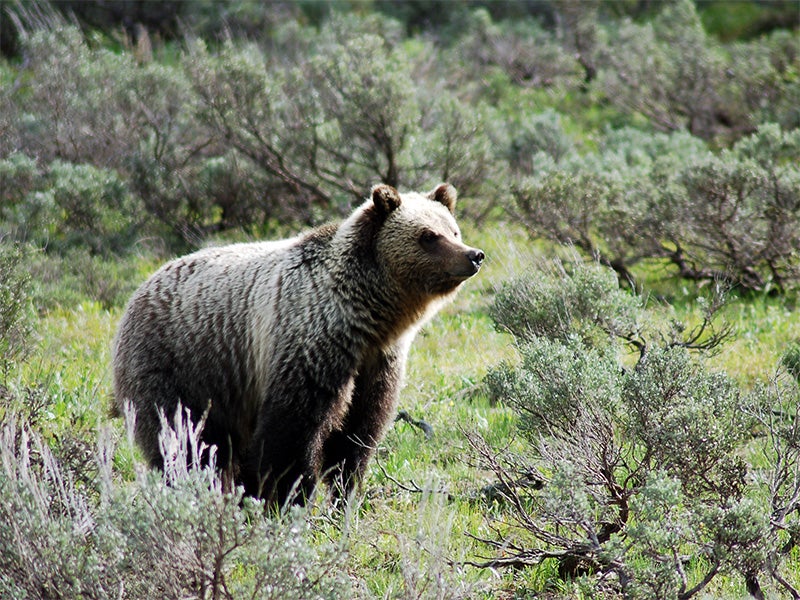Conservationists Challenge Grizzly Killing in Grand Teton National Park
Federally approved ‘take’ of grizzly bears threatens recovery
Contact
Conservation groups have filed a legal challenge against two federal agencies for approving the killing of four grizzly bears, a threatened species, within Grand Teton National Park in northwest Wyoming.
The lawsuit, filed last Friday, April 3, by Earthjustice on behalf of the Sierra Club and Western Watersheds Project, targets September 2013 actions by the U.S. Fish and Wildlife Service (FWS) and National Park Service to allow the lethal “taking” of four grizzly bears over the next seven years in connection with a fall elk hunt in Grand Teton National Park.
“Authorizing the killing of four grizzly bears in a national park is not good management for grizzlies or national parks,” said Earthjustice attorney Tim Preso. “The government should be working to eliminate grizzly mortality threats, not handing out authorizations to kill grizzly bears in one of our nation’s premiere national parks.”
The agencies authorized the challenged grizzly “takings” in response to an incident on Thanksgiving Day 2012 in which three hunters participating in the Grand Teton elk hunt shot and killed an adult male grizzly bear. Anticipating more such conflicts as the region’s grizzlies increasingly turn to meat-based food sources such as hunter-killed or wounded elk, federal officials in September 2013 approved the killing of four more grizzly bears in connection with future elk hunts in Grand Teton through the year 2022.
In doing so, however, government officials failed to consider the cumulative impacts of the expected Grand Teton “takings” together with other grizzly bear mortality that federal agencies have authorized. The authorized killing of these four grizzlies, when added to the amount of other similar grizzly “take” determinations issued by FWS and currently in effect for other actions in the Greater Yellowstone region, could result in the killing of as many as 65 female grizzly bears in a single year. This level of mortality exceeds sustainable levels for female bears set by government biologists by more than three times.
"Allowing four additional grizzly bears—a threatened species—to be killed in one our nation's most iconic national parks, without even requiring significant measures to reduce conflicts between people and bears, is inexcusable," said Bonnie Rice with Sierra Club’s Our Wild America campaign. "The Fish and Wildlife Service has repeatedly increased the number of grizzly bears that can be killed, without looking at the broader impact on grizzly recovery in the region.”
“Throughout the Greater Yellowstone Ecosystem the U.S. Fish and Wildlife Service appears to have forgotten basic math,” added Jonathan Ratner of Western Watersheds Project. “They have been handing out permits for the killing of grizzly bears like candy but they have conveniently forgotten to add up all of the take they have authorized.”
Background
Federal biologists acknowledge that the growth of the Yellowstone grizzly bear population has flattened over the past decade. Recently, the grizzly population has been faced with the loss of two of its most important food sources in the Yellowstone region—whitebark pine seeds and cutthroat trout—due to changing environmental conditions driven in part by a warming climate. In the wake of these changes, scientists have documented the bears’ transition to a more meat-based diet, but that diet leads to a greater potential for conflict with human activities, resulting in more grizzly mortalities.
Such increasing grizzly bear mortalities are of particular concern because analysis of government grizzly bear conflict and mortality data shows a declining population trend for the Yellowstone-area population from 2007-2013. Veteran grizzly biologist David Mattson documented these findings in a declaration supporting the conservationists’ challenge.
In its decision, FWS reasoned that approved grizzly killing associated with the Grand Teton elk hunt would remain within sustainable levels. However, the conservationists contend that FWS cannot rely on compliance with sustainable grizzly mortality thresholds to justify additional killing of Yellowstone bears unless federal officials consider the impacts of all the grizzly bear mortality they have anticipated across the region.
The Grand Teton elk hunt results from a misguided program of winter elk feeding on the nearby Jackson Hole National Elk Refuge. The longstanding elk feeding program began for the altruistic purpose of sustaining elk through the harsh Northern Rockies winter. More recently, however, the crowding of elk on winter feed lines has been documented to subject the elk to a severe threat of wildlife disease mortality that outweighs the benefits of feeding. Further, the practice has led to the artificial inflation of the elk population such that the extraordinary step of hunting in a national park—with associated grizzly bear mortality—has been deemed necessary to control elk numbers.

Additional Resources
About Earthjustice
Earthjustice is the premier nonprofit environmental law organization. We wield the power of law and the strength of partnership to protect people's health, to preserve magnificent places and wildlife, to advance clean energy, and to combat climate change. We are here because the earth needs a good lawyer.